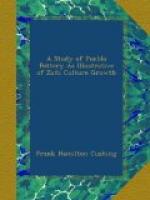That this clay lining should grow hard from continual heating, and in some instances separate from its matrix of osiers, is apparent. The clay form thus detached would itself be a perfect roasting-vessel.
POTTERY SUGGESTED BY CLAY-LINED BASKETRY.
This would suggest the agency of gradual heat in rendering clay fit for use in cookery and preferable to any previous makeshift. The modern Zuni name for a parching-pan, which is a shallow bowl of black-ware, is thle mon ne, the name for a basket-tray being thlae’ lin ne. The latter name signifies a shallow vessel of twigs, or thla we; the former etymologically interpreted, although of earthenware, is a hemispherical vessel of the same kind and material. All this would indicate that the thlae’ lin ne, coated with clay for roasting, had given birth to the thle mon ne, or parching-pan of earthenware. (See Fig. 502.)
[Illustration: FIG. 502.—Zuni earthenware roasting tray.]
Among the Havasupai, still surviving as a sort of bucket, is the basket-pot or boiling-basket, for use with hot stones, which form I have also found in some of the cave deposits throughout the ancient Zuni country. These vessels (see Fig. 503) were bottle-shaped and provided near the rims of their rather narrow mouths with a sort of cord or strap-handle, attached to two loops or eyes (Fig. 503 a) woven into the basket, to facilitate handling when the vessel was filled with hot water. In the manufacture of one of these vessels, which are good examples of the helix or spirally-coiled type of basket, the beginning was made at the center of the bottom. A small wisp of fine, flexible grass stems or osiers softened in water was first spirally wrapped a little at one end with a flat, limber splint of tough wood, usually willow (see Fig. 504). This wrapped portion was then wound upon itself; the outer coil thus formed (see Fig. 505) being firmly fastened as it progressed to the one already made by passing the splint wrapping of the wisp each time it was wound around the latter through some strands of the contiguous inner coil, with the aid of a bodkin. (See Fig. 506.) The bottom was rounded upward and the sides were made by coiling the wisp higher and higher, first outward, to produce the bulge of the vessel, then inward, to form the tapering upper part and neck, into which, the two little twigs or splint loop-eyes were firmly woven. (See again Fig. 503 a.)
[Illustration: FIG. 503.—Havasupai boiling-basket.]
[Illustration: FIG. 504. FIG. 505.
FIG. 506.
Sketches
illustrating manufacture of
spirally-coiled
basketry.]
[Illustration: FIG. 507.—Typical basket decoration.]
[Illustration: FIG. 508.—Typical basket decoration.]
[Illustration: FIG. 509.—Typical basket decoration.]




